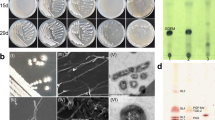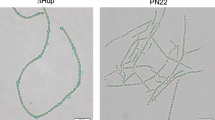Abstract
Nostoc punctiforme is a filamentous cyanobacterium that is capable of dark heterotrophy and cellular differentiation into nitrogen-fixing heterocysts, motile hormogonia, or spore-like akinetes. The study of akinete differentiation at the molecular level has been limited by the asynchronous development and limited number of akinetes formed within a filament. A system in which to study the development and genetic regulation of akinetes was investigated using a zwf mutant lacking glucose-6-phosphate dehydrogenase, the initial enzyme of the oxidative pentose phosphate pathway. Upon dark incubation in the presence of fructose, the zwf− strain ceased growth and differentiated into akinete-like cells, whereas the wild-type strain exhibited heterotrophic growth. Dark-induced zwf akinetes exhibited periodic acid–Schiff staining characteristics identical to that observed for wild-type akinetes, and synchronous induction of akinetes occurred in treated cultures. Dark-induced zwf akinetes exhibited increased resistance to the environmental stresses of desiccation, cold, or treatment with lysozyme relative to vegetative cells of both strains. Transcription of the avaK akinete marker gene was strongly induced in developing zwf akinetes as shown by Northern blotting and green fluorescent protein transcriptional reporter fusions. ATP levels did not vary significantly between dark incubated strains, indicating that a signal other than energy level may trigger akinete formation. This phenotypic and genetic evidence showing near-synchronous induction of dark-induced zwf akinetes indicates that this system will provide a valuable tool for the molecular genetic study of akinete development in N. punctiforme.






Similar content being viewed by others
References
Adams DG, Duggan PS (1999) Heterocyst and akinete differentiation in cyanobacteria. New Phytol 144:3–33
Allen M, Arnon DI (1955) Studies on nitrogen-fixing blue-green algae. I. Growth and nitrogen fixation by Anabaena cylindrica Lemm. Plant Physiol 30:366–372
Argueta C, Yuksek K, Summers M (2004) Construction and use of GFP reporter vectors for analysis of cell-type-specific gene expression in Nostoc punctiforme. J Microbiol Methods 59:181–188
Campbell EL, Hagen KD, Cohen MF, Summers ML, Meeks JC (1996) The devR gene product is characteristic of receivers of two-component regulatory systems and is essential for heterocyst development in the filamentous cyanobacterium Nostoc sp. strain ATCC 29133. J Bacteriol 178:2037–2043
Cardemil L, Wolk CP (1979) The polysacharrides from heterocyst and spore envelopes of a blue-green alga. Structure of the basic repeating unit. J Biol Chem 254:736–741
Cardemil L, Wolk CP (1981) Polysaccharides from the envelopes of heterocysts and spores of the blue-green algae Anabaena variabilis and Cylindrospermum licheniforme. J Phycol 17:234–240
Cohen MF, Meeks JC, Cai YA, Wolk CP (1998) Transposon mutagenesis of heterocyst-forming filamentous cyanobacteria. Methods Enzymol 297:3–17
Gantar M, Elhai J, Jia J, Ow M (1995) Predisposition towards heterocyst differentiation by individual cells of Anabaena. In: Bryant DA, Straus NA (eds) Abstracts of the fifth cyanobacterial molecular biology workshop, Pacific Grove, California, p 25
Hagen KD, Meeks JC (2001) The unique cyanobacterial protein OpcA is an allosteric effector of glucose-6-phosphate dehydrogenase in Nostoc punctiforme ATCC 29133. J Biol Chem 276:11477–11486
Hill DR, Keenan TW, Helm RF, Potts M, Crowe LM, Crowe JH (1997) Extracellular polysaccharide of Nostoc commune (Cyanobacteria) inhibits fusion of membrane vesicles during desiccation. J Appl Phycol 9:237–248
Hirosawa T, Wolk CP (1979) Factors controlling the formation of akinetes adjacent to heterocysts in the cyanobacterium Cylindrospermum licheniforme Kütz. J Gen Microbiol 114:423–432
Huang X, Dong Y, Zhao J (2004) HetR homodimer is a DNA-binding protein required for heterocyst differentiation, and the DNA-binding activity is inhibited by PatS. Proc Natl Acad Sci USA 101:4848–4853
Humason GL (1967) Animal tissue techniques, 2nd edn. W.H. Freeman, San Francisco
Leganés F (1994) Genetic evidence that hepA gene is involved in the normal deposition of the envelope of both heterocysts and akinetes in Anabaena variabilis ATCC 29413. FEMS Microbiol Let 123:63–67
Leganés F, Fernández-Piñas F, Wolk CP (1994) Two mutations that block heterocyst differentiation have different effects on akinete differentiation in Nostoc ellipsosporum. Mol Microbiol 12:679–684
Liu D, Golden JW (2002) hetL overexpression stimulates heterocyst formation in Anabaena sp. strain PCC 7120. J Bacteriol 184:6873–6881
Meeks JC, Wycoff KL, Chapman JS, Enderlain CS (1983) Regulation of expression of nitrate and dinitrogen assimilation by Anabaena species. Appl Environ Microbiol 45:1351–1359
Meeks JC, Campbell EL, Summers ML, Wong FC (2002) Cellular differentiation in the cyanobacterium Nostoc punctiforme. Arch Microbiol 178:395–403
Simon RD (1977) Macromolecular composition of spores from the filamentous cyanobacterium Anabaena cylindrica. J Bacteriol 129:1154–1155
Soriente A, Gambacorta A, Trincone A, Sili C, Vincenzini M, Sodano G (1993) Heterocyst glycolipids of the cyanobacterium Cyanospira rippkae. Phytochem 33:393–396
Summers ML, Wallis JG, Campbell EL, Meeks JC (1995) Genetic evidence of a major role for glucose-6-phosphate dehydrogenase in nitrogen fixation and dark growth of the cyanobacterium Nostoc sp. strain ATCC 29133. J Bacteriol 177:6184–6194
Sutherland JM, Herdman M, Stewart WDP (1979) Akinetes of the cyanobacterium Nostoc PCC 7524: Macromolecular composition, structure and control of differentiation. J Gen Microbiol 115:273–287
Thiel T, Wolk CP (1983) Metabolic activities of isolated akinetes of the cyanobacterium Nostoc spongiaeforme. J Bacteriol 156:369–374
Wolk CP, Ernst A, Elhai J (1994). Heterocyst metabolism and development. In: Bryant DA (ed) The molecular biology of Cyanobacteria. Kluwer, Boston, pp 769–823
Wong FC, Meeks JC (2002) Establishment of a functional symbiosis between the cyanobacterium Nostoc punctiforme and the bryophyte Anthoceros punctatus requires genes involved in nitrogen control and initiation of heterocyst differentiation. Microbiol 148:315–323
Yang C, Hua Q, Shimizu K (2002) Metabolic flux analysis in Synechocystis using isotope distribution from 13C-labeled glucose. Metabol Eng 4:202–216
Zhou R, Wolk CP (2002) Identification of an akinete marker gene in Anabaena variabilis. J Bacteriol 184:2529–2532
Zhou R, Wolk CP (2003) A two-component system mediates developmental regulation of biosynthesis of a heterocyst polysaccharide. J Biol Chem 278:19939–19946
Acknowledgements
This work was supported by NSF grant MCB0093327, and NIH grants GM48680 and GM63787.
Author information
Authors and Affiliations
Corresponding author
Rights and permissions
About this article
Cite this article
Argueta, C., Summers, M.L. Characterization of a model system for the study of Nostoc punctiforme akinetes. Arch Microbiol 183, 338–346 (2005). https://doi.org/10.1007/s00203-005-0778-5
Received:
Revised:
Accepted:
Published:
Issue Date:
DOI: https://doi.org/10.1007/s00203-005-0778-5




